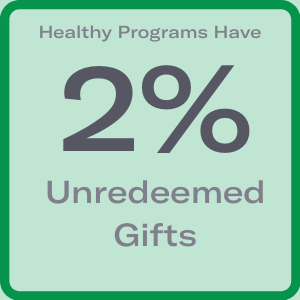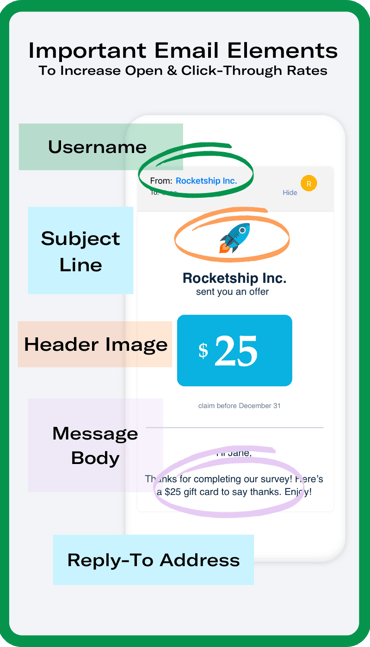You’ve spent time and effort creating your recognition or incentive program. From obtaining budget approvals to developing customer or employee communications, kicking off an incentive or rewards program is not easy. Your program is up and running - now what?
As your program is off the ground, now is the time to optimize the performance - to drive your ultimate desired results.
If you are running a customer loyalty program, monitor your metrics and make sure that you see an increase in repeat purchases and customer lifetime value (LTV) - above and beyond the cost of the rewards and program maintenance.
If you are running an employee reward program, look for increases in positive feedback from your employee satisfaction survey (which you hopefully perform more than annually!).
While seeing improvements in some of these statistics may take some time, the first metric you can focus on is your reward redemption rate. Before your customers or employees can have a positive association with your company by spending their rewards, they must redeem them - hence, reward redemption is an initial indicator in the health of your program.
Reward & Incentive Redemption Rates
Reward and Incentive redemption rates are important regardless of the type of program - customer loyalty, customer sales incentives, employee rewards, etc. To ultimately drive your desired behavior, your reward program should excite and delight your audience - through redeeming and using their rewards.
When you are delivering a digital reward via email, your email metrics are your leading indicators of your reward redemption rate. After all, if your customers or employees are not receiving, opening, or clicking through your reward email, they won’t be able to redeem their reward.

From our experience at Giftbit, a healthy program has only 2% unredeemed gifts. If you are below that rate, read on for tips on how to improve.
Email Delivery Tips
To start off bluntly - some causes of delivery failure are controllable while others are not. Meaning - you can’t control everything about your email delivery rates, but don’t despair! There are some things you can optimize to ensure the highest email delivery rate possible.
Let's start by understanding how email delivery works and what the potential pitfalls are.
Mail delivery has three basic outcomes:
- Success! The message is transmitted to the recipient’s email service and the receiving mail server confirms receipt. While a success message is the first positive step, keep in mind that successful transmission does not guarantee the message is routed to an inbox. The message can still end up quarantined or diverted to the spam folder. (Keep reading for tips on how to avoid quarantine or spam!)
- Delayed Delivery is delayed because the recipient’s inbox is full, or the recipient's email service is unavailable or unresponsive. Most email services (including Giftbit) will reattempt transmission reattempted at a later point in time, so no action should be needed on your part. If the message is unable to be delivered a second time, it will be become a failed response.
- Failed The recipient's email service responds with a delivery failure, because the intended email address is not valid, or the contact has opted out of email communication from the sender.
Now that you know what can happen to your reward email, let's focus on how to get to the success outcome.
Failed Messages
For failed responses, the number one most impactful element is to improve contact information (i.e., email addresses) for your recipients. For reward programs where you are sending to external recipients (outside of your organization), you can improve your failure rate by:
- Requiring your contacts to verify their email address before sending your rewards,
- Explaining how email addresses will be used when you collect them - so that the recipient knows not to provide spurious details, and
- Running some basic checks on your recipient email addresses before sending. Look for common typos (gnail instead of gmail, for example) and correct if possible.
Success Messages
Once you have your emails being delivered (i.e., a “success” response message), there are still reasons your reward email may not appear in your recipient’s inbox. Let’s look at common reasons and tips & tricks to use to improve.
Quarantined Messages
Quarantine refers to when messages are trapped by the recipient's email administrator due to keyword filters or behavior related to junk mail and other unsolicited mail. When your reward email is quarantined, your recipient may not even see it in their junk email folder.
To avoid quarantined messages:
- For internal recipients - employees or colleagues within your company - ask your IT department to whitelist the email domain your rewards will come from. For example, if you use Giftbit, you would whitelist giftbit.com.
- For external individual recipients, you may not know if your reward email was quarantined. But, if your reward recipient cannot locate your reward email, a good starting point is to ask them to add your sending email address to their contact list. For Giftbit, this would be gifts@giftbit.com.
- If you are planning to send rewards to multiple professional contacts in the same organization (not your organization!), try to change your email up slightly. If you send the same message to multiple contacts, your message may be misconstrued as junk mail. If you need to send the same message to multiple contacts, ask if their administrator is willing to whitelist your sending domain in advance.

Junk Email
If you aren’t careful with the wording of your email, the recipient’s email provider may treat your message as junk mail which can be be frustrating for you and your recipients. Keep the message on topic and avoid commonly flagged keywords like "free" and "easy".
Email Open & Click Through Tips
While the success of email delivery is largely based on who the reward was sent to, email open activity and click-through-rate (CTR) is a function of trust, sender identity, and messaging. 
Email Open
Once your email is successfully delivered to your recipients inbox, they still need to open and read your reward email before they can redeem. To improve your email open rate, focus on your email reward message and follow these best practices.
Username
This detail appears in the recipient’s inbox before he or she opens the email. Best practice includes either using a company or brand name for their username, or selecting a member of their team to represent the brand. Either way, select a username that is reasonably familiar to recipients.
Subject Line
Don't underestimate the importance of a good subject line! The subject line is one of two details (the other being your username) that your recipient will see when the reward email is delivered - before they open it. A bad subject line could cause your recipients to ignore or delete your message.
For ongoing reward programs, try testing different subject lines and monitoring the impact on email open rates. You may wish to test a subject line designed to stand out in a crowded inbox against a very focused subject line which makes the intent of the message (your reward program!) as clear as possible.
Whatever style you try, be sure to avoid using commonly flagged keywords that could get your message flagged as junk - such as “easy” or “free”. And, keep the length of the subject line to a single sentence or shorter.
Click-Through-Rate
Now that your reward email has been delivered to your recipients inbox, and they have opened it, they need to click through your call-to-action to redeem their reward. There are many factors that influence your click-through-rate - do your best to optimize all of them.
Reply-To Address
The reply-to address is mentioned in the footer email. Contacts who have difficulty remembering their relationship to your brand or rewards program may review this detail to confirm the source of the email. Like the username, sometimes it is better to use the email of a specific team member and sometimes it is better to use a general inbox along the lines of rewards@yourcompany.com. Whichever you choose, be sure the domain of the reply-to address is recognizable to your recipient.
Header Image
Many people are visually oriented, so including your brand or rewards program logo can make all the difference for recognition and trust.
Message Body
An effective message body is personalized, informative, and clearly worded. The message body is important for click-through-rates because it reinforces trust in the source of the reward, which is critical anytime people interact with email links, money, gift cards or related value online.
- Don't assume that your recipients will recognize the reward without a reminder; he or she might have momentarily forgotten their relationship to you. Best practice is to include a reminder of the program and reason for the digital reward in the message.
- A personalized greeting greatly improves trust. If possible, use a greeting paired with an embedded data field to dynamically insert the right first name for each contact in the message body.
- Include information about your reward - what your recipient can redeem for, and the value of the reward.
Reward Redemption Rate
Now that your reward recipient has received your email, opened, and clicked through - what next? The answer really depends on your program - but ultimately comes down to two primary factors.
Reward Value & Options
The value of each reward will likely be a function of the budget for your rewards program and you may not be able to alter this detail. However, in general, the value of the reward has to be worthwhile for the effort asked of the recipient. The higher the value of the reward, the more effort recipients will put into the redemption process.
In addition, offering multiple reward options or gift card brands improves the appeal and flexibility of the reward to a variety of age groups and preferences. While some recipients may value physical rewards, including plaques, pens, etc., (we wouldn't, and we haven't met any people who would - but then again, perhaps we are biased!) many may prefer gift cards. Giving choice, including offering a variety of gift card brands to choose from, will drive higher redemption rates.
And if you are using gift cards as your reward medium, be sure that the reward and brand option(s) align with your reward value. For example - a $5 gift card for a coffee shop is useful enough, but the same value for a clothing retailer may seem inconvenient because the gift card isn't enough to complete a purchase.
Redemption Experience Optimization
If you are using a third-party provider - such as Giftbit - you may not be able to influence the redemption experience very much. However, if you are hosting your own solution, A/B testing to find areas to optimize the experience should be on your radar. In general, follow best practices for any eCommerce flow, including:
- Make your redemption experience as simple and easy as possible. While offering reward choices can increase your redemption rate, don’t offer too many. There is a law of diminishing returns on the number of choices - as you get above approximately 15 options, you will likely see your reward redemption rate decrease as your recipients become overwhelmed.
- Make your checkout flow as simplistic as possible. If your recipient selected a physical reward that must be mailed, then you must collect their home address. If they selected a digital reward, such as a gift card, then optimize your experience by removing unnecessary address fields.
- Ensure that the overall experience is friction free by ensuring the website is fast and secure.
If you implement the best practices listed above, you should see an increase in your reward email deliverability, open and click through rates, and reward redemption rates.
Tags:
Marketing Incentives/Logo%20no%20tagline%2c%20small.webp?width=150&height=56&name=Logo%20no%20tagline%2c%20small.webp)










